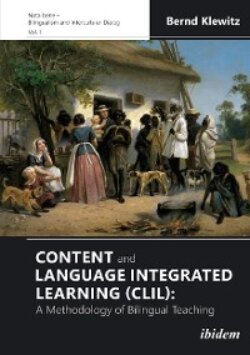Читать книгу Content and Language Integrated Learning (CLIL): A Methodology of Bilingual Teaching - Bernd Klewitz - Страница 3
ОглавлениеTable of Contents
Introduction
Chapter 1 Bilingual Children
Vignette “A Family Experiment”
1.1 Dismantling Myths and Legends of Bilingualism
1.2 The Guide for Bilingual Parents
1.3 The Graduate Medical School of Hanover
1.4 The Gap Between Knowing and Doing
1.5 The Dual System Hypothesis
1.6 The Unitary Language System Hypothesis
Chapter 2 Nativist and Cognitive Positions
Vignette “Language is the dress of thought”
2.1 The Research on Second Language Acquisition
2.2 Behaviorism and a Black Box
2.3 The Universal Grammar and Noam Chomsky
2.4 The Minimalist Position of Recursion
2.5 The Input and Output Hypotheses
2.6 Language Learning as a Social Process—The Zone of Proximal Development (ZPD)
Chapter 3 Nature versus Nurture
Vignette “The American Experience”
3.1 The Fundamental Difference Hypothesis
3.2 Linking Nature and Nurture
3.3 Anthropology Sheds a New Light
3.4 The Neuro-biological View
3.5 The Task-based Approach
Chapter 4 Learning (Foreign) Languages in Cultural Contexts—Historic and Current Developments
Vignette “The Dunera Boys”
4.1 Communicative Language Teaching and the Grammar Question
4.2 The Common European Framework for Languages
4.3 Rethinking Foreign Language Teaching
4.4 The Two Tales of CLIL
4.5 CLIL Example—Teaching “Bauhaus” Professor Ingrid Zeller; Northwestern University
Chapter 5 Dimensions and Contexts of Bilingual Teaching
Vignette “Intercultural Encounters in Student Exchanges”
5.1 Scotland
5.2 Canada and the US
5.3 Australia (& Deutsche Schule Melbourne)
5.4 Germany and Europe
5.5 Learning Principles
5.6 Principles of Quality Teaching (Luther College)
5.7 Teaching Design as an Instructional Model (McKinnon Secondary College)
5.8 Linguistic Risk Taking (Ottawa)
Chapter 6 Building Blocks of CLIL
Vignette “Windows in the Foreign Language Classroom”
6.1 Features of Multi-perspective Learning
6.2 Guiding Questions for CLIL Lesson Planning
6.3 The 4 Cs Framework
6.4 Discourse Competences—Bridging BICS and CALP
6.5 The Language Triptych
6.6 The Bilingual Triangle and the Third Space
6.7 Task Design Wheel and Task-verbs
6.8 Primacy of Content
6.9 Scaffolding as a Dual Teaching Strategy
Chapter 7 Literary CLIL
Vignette “Intertextuality”
7.1 Literature as Part of the Bilingual Curriculum
7.2 Literature in the CEF
7.3 Selection Criteria
7.4 Narratives of Literary CLIL
7.5 Literary CLIL as a Theory of Practice
7.6 Study Design for Literary Analysis and Criticism
7.7 Literary Studies in Contexts, Genres and Target Countries
7.8 Intertextuality
Chapter 8 CLIL Tools and Skills
Vignette “Worksheet Compass”
8.1 Scaffolding as a Tool in CLIL
8.2 Task-based Language Teaching (TBLT)
8.3 English Unlimited (blended content-language learning)
8.4 The Visual Turn
8.5 Learnscapes
Chapter 9 CLIL Modules
Vignette “Teaching Units”
9.1 Measuring Your Media (A2)
9.2 Refugees (A2)
9.3 Analysing Political Cartoons (B1)
9.4 Jacobites and Enlightenment (B1)
9.5 Caledonia—Creating a Podcast (B2)
9.6 War and Peace—Calvin and Hobbes (B2)
9.7 Herringbone Technique (B2+)
9.8 Absolutism (B2+)
9.9 Reciprocal Teaching (C1)
9.10 International Relations—Libya (C1)
Chapter 10 CLIL Challenges and Desiderata
Vignette “Venn Diagram”
10.1 CLIL as a Catalyst for Change
10.2 The Innovative Potential
10.3 Competence and Content—a CLIL Example
10.4 Future Directions
Glossary of Teaching Strategies and Learning Skills
Content and Language Integrated Learning (CLIL): A Methodology of Bilingual Teaching
